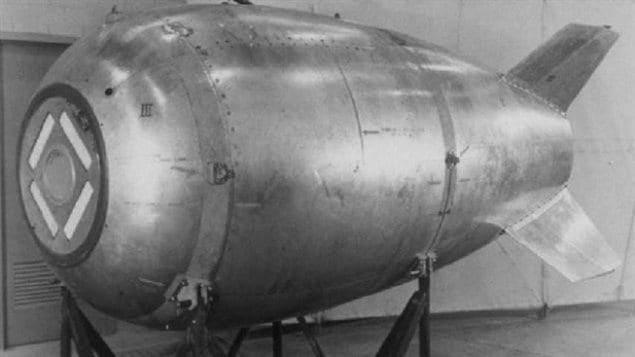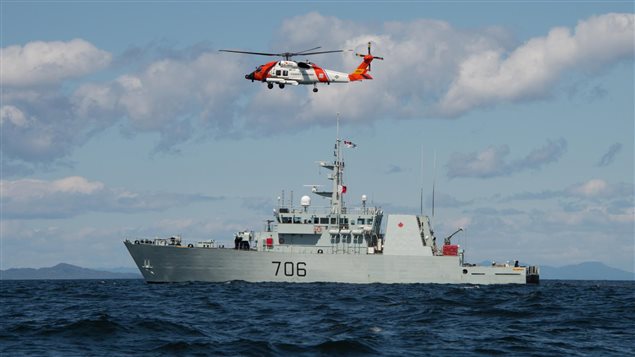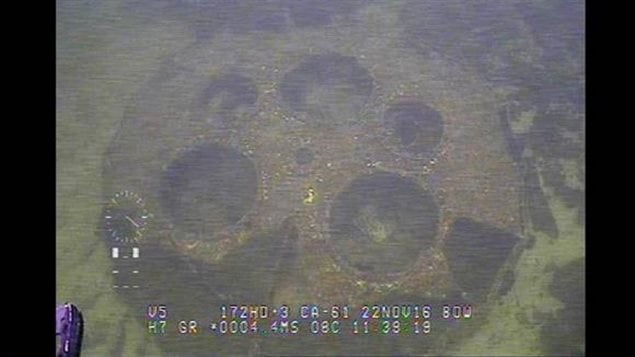The mysterious object found by an intrepid diver in the waters off the coast of British Columbia is definitely not a long-lost U.S. nuclear bomb, says the Royal Canadian Navy.
“The RCN has confirmed the object is not an unexploded military munition, and poses no risk to the local population,” the navy said Friday afternoon.
But that’s pretty much all they can say for certain about the strange object, a steel piece of industrial equipment with yellow paint measuring approximately 5.5 m in length and 1 m in height, found at the depth of 8 metres of water.
So the Canadian Armed Forces are asking for the public’s assistance in identifying the strange subject. They’ve posted the photos captured by a remotely operated vehicle launched from HMCS Yellowknife to investigate the object.
Boiler? Piece of a rocket?
The most common comment so far is that this mysterious piece of equipment is probably a part of a boiler.
British Columbia diver Sean Smyrichinsky found the mystery object during a recent diving trip near Banks Island.
“I got a little far from my boat and I found something that I’d never ever seen before,” he said in an interview with the CBC’s Daybreak North program in early November. “It resembled, like, a bagel cut in half, and then around the bagel these balls all cut into it, molded into it… It was the strangest thing that I had ever seen.”
Smyrichinsky’s first impression was that he must have come across something completely alien.
“I came out from the dive and I came up and I started telling my crew ‘my god, I found a UFO!’”
Cold War bomber crash
When Smyrichinsky started asking around from more veteran divers about possible origins of the strange object, he was told the story of Convair B-36B, a US Air Force bomber that crashed off B.C.’s north coast in 1950.
When the boat he was on finally came into a cell reception area, Smyrichinsky was finally able to do some online sleuthing of his own. He found out that the bomber and its crew of 17 people was carrying a nuclear bomb, a Mark IV, which was never found after the plane crashed.
As soon as he looked up Google images of Mark IV the resemblance with the object he saw at the bottom of the ocean was obvious, Smyrichinsky said.

“It was a piece that looked very much like what I saw, a big circle with these balls,” Smyrichinsky said. “I had no idea that a nuclear bomb contained all these big balls, bigger than basketballs.”
The Convair B-36B had crashed about 50 miles south of where he found the object, Smyrichinsky said.
Navy sent to investigate
Smyrichinsky’s story and the media attention it got piqued the interest of the RCN, which decided to dispatch HMCS Yellowknife, a coastal defence vessel, to investigate the find.

“Scheduled to conduct Route Survey operations in the vicinity of Queen Charlotte Sound, British Columbia, HMCS Yellowknife and its crew were re-directed to an area south of Prince Rupert in response to an RCMP request to investigate an unknown subsurface object,” the navy statement said. “Media reports speculated the object could be related to a crash of the United States Air Force B-36 Peacemaker in 1950.”
The navy took Smyrichinsky with them so he can pinpoint the location of his find.
The crew of HMCS Yellowknife used onboard sonar systems, a remotely operated vehicle and a dive team to locate the object.
“We are pleased that HMCS Yellowknife was able to locate the object and determine that the object was not an unexploded military munition,” said Cmdr. Michele Tessier, Commander Coastal Division, Maritime Forces Pacific. “The RCN is pleased to relieve any concerns in the local communities.”








For reasons beyond our control, and for an undetermined period of time, our comment section is now closed. However, our social networks remain open to your contributions.